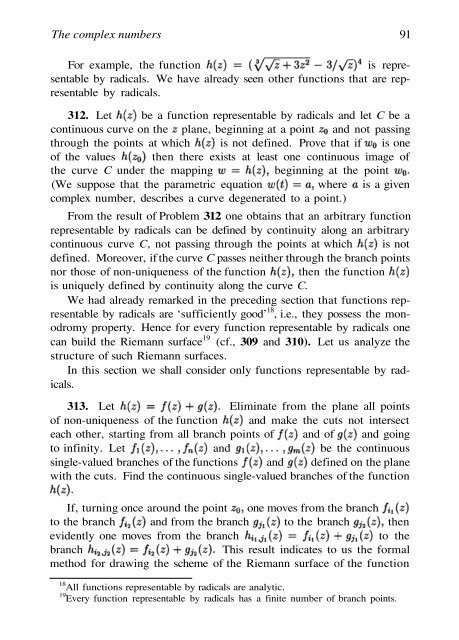Abel's theorem in problems and solutions - School of Mathematics
Abel's theorem in problems and solutions - School of Mathematics
Abel's theorem in problems and solutions - School of Mathematics
Create successful ePaper yourself
Turn your PDF publications into a flip-book with our unique Google optimized e-Paper software.
The complex numbers 91<br />
For example, the function is representable<br />
by radicals. We have already seen other functions that are representable<br />
by radicals.<br />
312. Let be a function representable by radicals <strong>and</strong> let C be a<br />
cont<strong>in</strong>uous curve on the plane, beg<strong>in</strong>n<strong>in</strong>g at a po<strong>in</strong>t <strong>and</strong> not pass<strong>in</strong>g<br />
through the po<strong>in</strong>ts at which is not def<strong>in</strong>ed. Prove that if is one<br />
<strong>of</strong> the values then there exists at least one cont<strong>in</strong>uous image <strong>of</strong><br />
the curve C under the mapp<strong>in</strong>g beg<strong>in</strong>n<strong>in</strong>g at the po<strong>in</strong>t<br />
(We suppose that the parametric equation where is a given<br />
complex number, describes a curve degenerated to a po<strong>in</strong>t.)<br />
From the result <strong>of</strong> Problem 312 one obta<strong>in</strong>s that an arbitrary function<br />
representable by radicals can be def<strong>in</strong>ed by cont<strong>in</strong>uity along an arbitrary<br />
cont<strong>in</strong>uous curve C, not pass<strong>in</strong>g through the po<strong>in</strong>ts at which is not<br />
def<strong>in</strong>ed. Moreover, if the curve C passes neither through the branch po<strong>in</strong>ts<br />
nor those <strong>of</strong> non-uniqueness <strong>of</strong> the function then the function<br />
is uniquely def<strong>in</strong>ed by cont<strong>in</strong>uity along the curve C.<br />
We had already remarked <strong>in</strong> the preced<strong>in</strong>g section that functions representable<br />
by radicals are ‘sufficiently good’ 18 , i.e., they possess the monodromy<br />
property. Hence for every function representable by radicals one<br />
can build the Riemann surface 19 (cf., 309 <strong>and</strong> 310). Let us analyze the<br />
structure <strong>of</strong> such Riemann surfaces.<br />
In this section we shall consider only functions representable by radicals.<br />
313. Let Elim<strong>in</strong>ate from the plane all po<strong>in</strong>ts<br />
<strong>of</strong> non-uniqueness <strong>of</strong> the function <strong>and</strong> make the cuts not <strong>in</strong>tersect<br />
each other, start<strong>in</strong>g from all branch po<strong>in</strong>ts <strong>of</strong> <strong>and</strong> <strong>of</strong> <strong>and</strong> go<strong>in</strong>g<br />
to <strong>in</strong>f<strong>in</strong>ity. Let <strong>and</strong> be the cont<strong>in</strong>uous<br />
s<strong>in</strong>gle-valued branches <strong>of</strong> the functions <strong>and</strong> def<strong>in</strong>ed on the plane<br />
with the cuts. F<strong>in</strong>d the cont<strong>in</strong>uous s<strong>in</strong>gle-valued branches <strong>of</strong> the function<br />
If, turn<strong>in</strong>g once around the po<strong>in</strong>t one moves from the branch<br />
to the branch <strong>and</strong> from the branch to the branch then<br />
evidently one moves from the branch to the<br />
branch This result <strong>in</strong>dicates to us the formal<br />
method for draw<strong>in</strong>g the scheme <strong>of</strong> the Riemann surface <strong>of</strong> the function<br />
18 All functions representable by radicals are analytic.<br />
19 Every function representable by radicals has a f<strong>in</strong>ite number <strong>of</strong> branch po<strong>in</strong>ts.

















